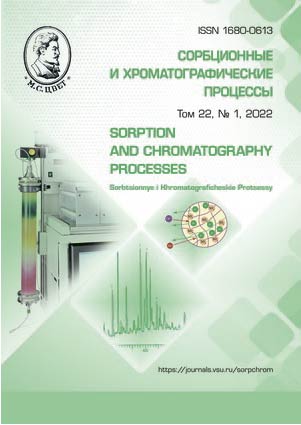Determination of α- and β-naphthols in their mixtures with micellar extraction preconcentration
Abstract
The study is devoted to the separate and cumulative determination of α- and β-naphthols with micellar extraction preconcentration by non-ionic surfactants and the use of digital colourimetry. The determination method is based on colour reactions of α- and β-naphthols with 4-nitrophenyldiazonium, 4-aminoantipyrine, and micellar extraction of their interaction products, which are azo compounds and quinonimines. This method allows the determination of α- and β-naphthols at the MPC level with an error not exceeding 10%. For the quantitative determination of naphthols, we applied generalised colourimetric parameters in the RGB colour system. We used the area (S) and perimeter (P) of the radar charts obtained by evaluating the intensity of R, G, and B colour components of two chromophore reactions. The reactions were based on the production of coloured derivatives by diazotation and azocoupling, as well as the oxidative condensation of naphthols. The colourimetric radar charts of α- and β-naphthol derivatives have an individual profile due to differences in their structure, which allows for their identification.
In order to compare the profiles of the radar charts of isomeric naphthols and their mixtures, we applied the similarity coefficients of the vector arrays. The coefficients allowed us to predict the ratio of isomers in a mixture. The geometrical parameters of the radar charts of single naphthol isomers in semi-logarithmic coordinates are adequately described by the linear equations S=blgC-a and P=blgC-a (approximation degree R2≥0.97). The parameters can be used to determine the concentration of the isomers in the range of 1·10-7-1·10-4 M. To assess the accuracy of the colourimetric determination of α- and β-naphthols, we used isocratic reversed-phase HPLC with UV detection at 265 nm. It was shown that the concentration of α- and β-naphthol derivatives in simple and combined non-ionic surfactant systems allowed their separate determination in the concentration range from 1·10-7-1·10-6 M. The developed process is an express method, it is economically and environmentally superior to the HPLC method as it requires no volatile and toxic solvents or expensive equipment.
Downloads
References
Sukhanov P.T. Diss. … doktora khim. nauk. Saratov. 2007. 385 p.
Suxanov P.T., Kalinkina S.P., Koren-man Ya.I., Zhurnal analiticheskoj khimii, 2007, Vol. 62, No 12, pp. 1245-1248.
Kalinkina S.P., Sukhanov P.T., Koren-man Ya.I., Churkina E.A., Sorbtsionnye i khromatograficheskie protsessy, 2005, Vol. 5, No 3, pp. 347-352.
Khorokhordina E.A., Chan Xaj Dang, Nauchny`j vestnik Voronezhskogo gosudar-stvennogo arxitekturnostroitel`nogo univer-siteta, 2014, Vol. 8, No 1, pp. 93-105.
Rudakov O.B., Khorokhordina E.A. E`kspressny`e metody` kontrolya kachestva i bezopasnosti texnicheskix materialov, Vo-ronezh, Izd-vo VGTU, 2017, 103 p.
Doronin S.Yu., Zhestovskaya E.S., Cygulyova E.I., Zhurnal analiticheskoj khimii, 2020, Vol. 75, pp. 502-509.
Kuduxova I.G., Rudakova L.V., Rudakov O.B., Nazarov V.M., Voda: khimiya i ekologiya, 2011, Vol. 42, No 12(42), pp. 89-93.
Rudakov O.B., Rudakova L.V., Kuduxova I.G. et al., Analitika i control, 2012, Vol. 16, No 4, pp. 368-377.
Chernova R.K., Doronin S.Yu. Opre-delenie organicheskix analitov v rastvorax PAV: ionny`e i micellyarny`e e`ffekty`, Saratov, Izd-vo SGU, 2017, 200 p







